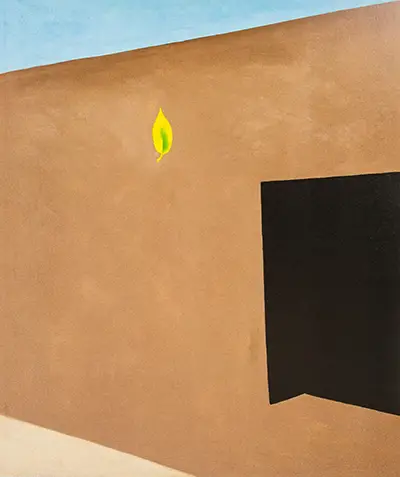At a glance, the painting depicts a wide brown wall with a patio door. According to the psychology of colors, the brown color could symbolize strength and reliability. Brown is as solid as the ground, and therefore associated with security, safety, dependability, and resilience. However, the vast brown color across the painting may also evoke feelings of loneliness, emptiness, and isolation like a huge desert without any life.
On the right side of the painting, a patio door appears to open into darkness. The other side of the door is completely dark, which may symbolize fear, sadness, unhappiness, or remorse in the mind of the artist. Throughout history, black symbolized death, bad omens, and evil. In the painting, the artist may be referring to the negative and dark thoughts that go on in the minds of people. It could also mean that Georgia was trying to bring to light the injustices that happen in the society or in life.
On the left side of the patio door is a green leaf on the wall. Since green generally means growth, life, and abundance, this could symbolize that there is always a light at the end of the tunnel. The green could also mean that even after the adversity and hardships depicted by the brown and black colors, life always finds a balance: things always get better with time. At the top left corner of the painting, there is a blue color, which could be a clear blue sky. The blue color has a calming effect to the mind and it creates an atmosphere of security, tranquility, peace, and order. Georgia O'Keeffe may have added the color to remind people that no matter how serious or tough a situation is, one should always strive to live a tranquil life full of serenity and peace of mind.
The painting is of oil on canvas and the dimensions of the painting are 36 inches by 30 inches. Currently, the painting is in the Georgia O'Keeffe Museum located along Johnson Street in downtown Santa Fe. The painting is a clear demonstration of how gifted Georgia O'Keeffe was. She received awards like the National Medal of Arts in 1985, the Presidential Medal of Freedom in 1977, and the Edward MacDowell Medal in 1972. Almost 35 years after her death, Georgia O'Keeffe is still the Mother of American Modernism.

